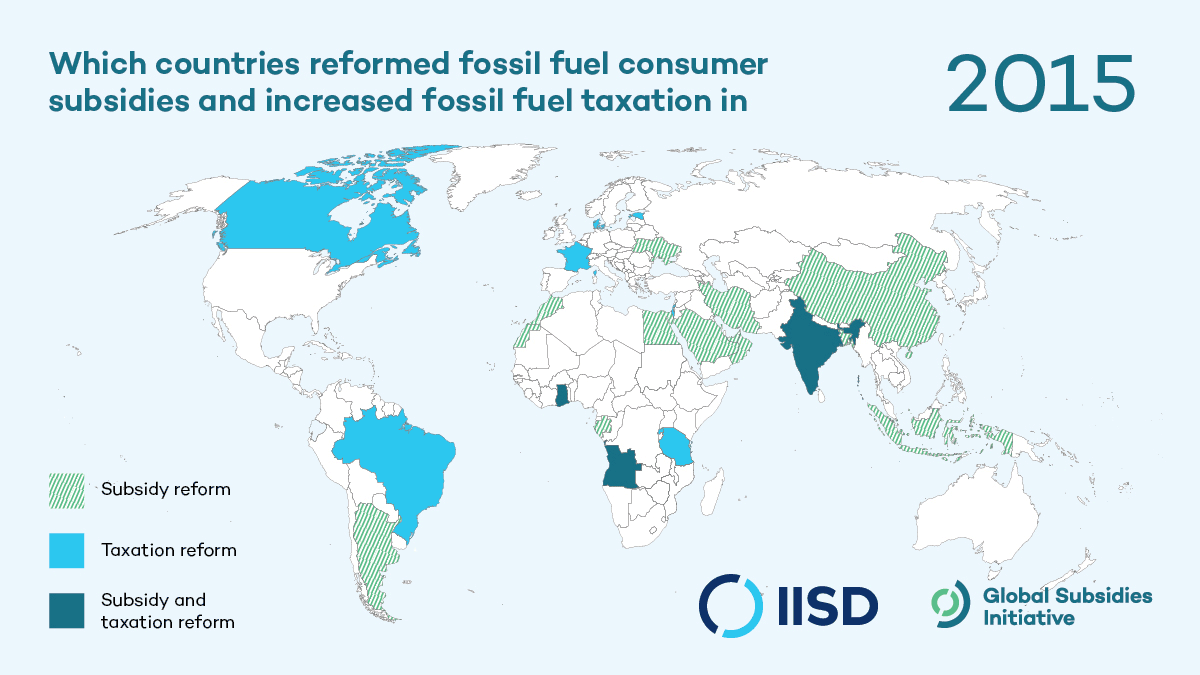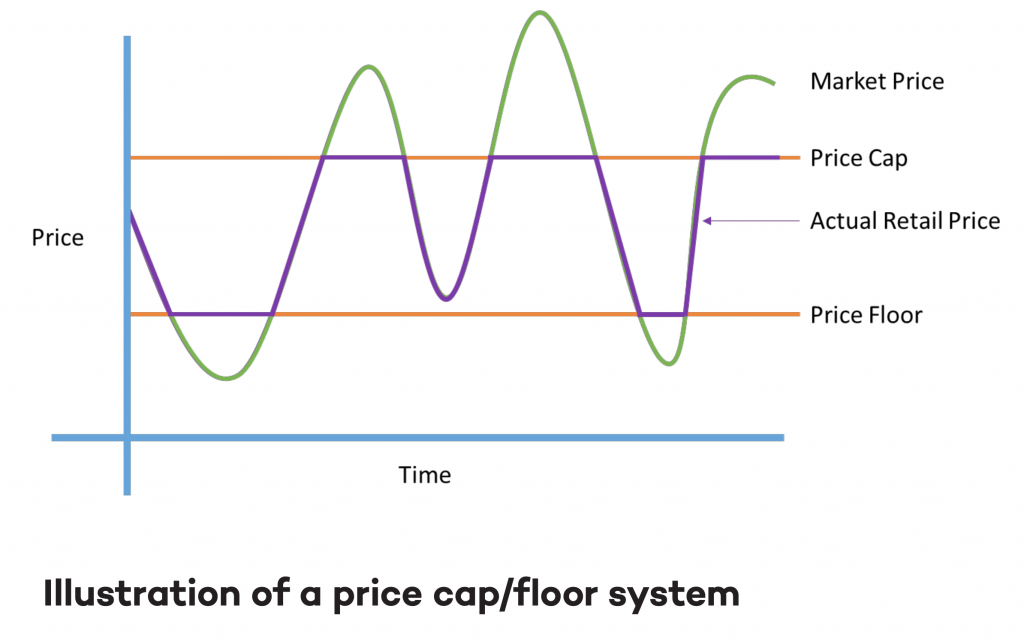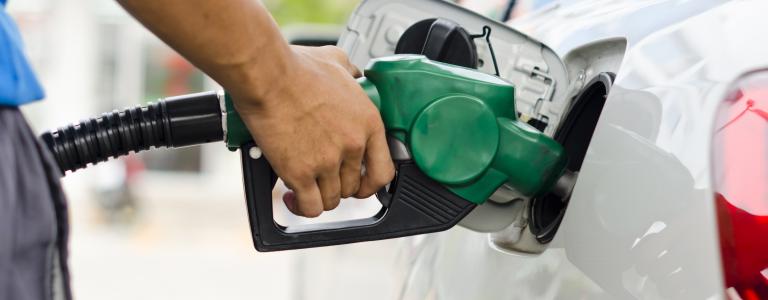53 Ways to Reform Fossil Fuel Consumer Subsidies and Pricing
The evidence is crystal clear that fossil fuel subsidies are environmentally harmful and undermine efforts to tackle climate change. In the aftermath of COVID-19, governments have an opportunity to use subsidy reform and fuel taxation as tools for a green recovery. Our experts explain what this could look like.
The evidence is crystal clear that fossil fuel subsidies are environmentally harmful and undermine global efforts to tackle climate change. Despite this, support for fossil fuels costs governments USD 300–600 billion every year—depending on fuel prices on the world markets—a huge sum that could otherwise be spent on global priorities such as health, education, social protection, and a just transition to a clean energy future.
As countries struggle to support their economies in the aftermath of the COVID-19 crisis, it’s more important than ever to align climate ambitions with economic priorities. Governments have the opportunity to look closely at fossil fuel subsidy reform and fuel taxation as effective tools for a green recovery as they work to maintain climate commitments while generating revenue to support pressing social needs.
The recent drop in global oil prices provides an exceptional chance for countries to reform their fossil fuel subsidies without burdening consumers, as fuel prices would remain low without government support. The drop in oil prices also opens a window of opportunity to improve fuel taxation: IISD experts have shown that a small tax on fossil fuels could generate much-needed funds to react to and recover from the COVID-19 crisis, while being fair toward—and having a moderated effect on—consumers.

Several countries are already seizing this opportunity, while many others are asking: what do successful fuel subsidy reform and fuel taxation look like in practice? To address this question, Global Subsidies Initiative (GSI) experts offer insight into global trends in tackling wasteful fossil fuel subsidies with a new detailed map of fossil fuel consumer subsidy reform and taxation between January 2015 and May 2020.
Our experts identified that within this period, at least 53 countries implemented some kind of fossil fuel consumer subsidy reform or increased taxes on fossil fuels. Breaking that down, we see that 34 countries reformed consumer subsidies, while 14 countries increased fossil fuel taxation, and seven countries did both. It is important to note that this list may not be comprehensive and remains a work in progress.
As countries struggle to support their economies in the aftermath of the COVID-19 crisis, it’s more important than ever to align climate ambitions with economic priorities.
It is also important to note that producer subsidies—subsidies to upstream oil, gas, and coal exploration, mining, and production—amount to at least USD 100 billion per year worldwide. There have been some producer subsidy reforms in the 2015–2020 period: for example, Germany has committed to phasing out subsidies to hard coal mining by the end of 2018 as part of the EU-wide commitment to end these subsidies.
On the other hand, recent low oil prices and the COVID-19 crisis have further degraded the economics of fossil fuel production, and this has led to the implementation of new producer subsidies in many jurisdictions. The Energy Policy Tracker, developed by IISD and 13 other partners, is one source of information for new support to the fossil fuel sector, and it is expected that reporting under SDG Indicator 12.c.1 should yield new, official information from this year (2020) as countries report. This further information will then help to assess whether countries are moving forward with reforming their producer subsidies.
IISD experts have shown that a small tax on fossil fuels could generate much-needed funds to react to and recover from the COVID-19 crisis, while being fair toward—and having a moderated effect on—consumers.
What Strategies Have Countries Used and How Did It Work Out?
Gradual Approach
Every country has a different starting point, and the policy specifics of each reform are unique. However, if there is one thing that we can learn from all governments that implemented fossil fuel subsidy reform or increased fossil fuel taxation, it’s the success of their phased approach.
We can see the benefits of this design in Egypt. Spending about 7% of its GDP on fossil fuel subsidies in 2013, Egypt has been reforming its consumer subsidies for the last six years, gradually freeing up resources to support other sectors such as health and education.
Egypt has been reforming its consumer subsidies for the last six years, gradually freeing up resources to support other sectors such as health and education.
Supported by the World Bank, Egypt approached its subsidy reforms step-by-step, taking careful measures to protect poor people from negative impacts through helpful initiatives like cash transfer programs. The reforms were accompanied by an effective communications strategy targeting citizens, which explained why the reforms were important and illustrating the tangible benefits the country was going to see as a result.
The Right Timing
Evidence shows that the timing of reforms can also play an important role in their success.
Between 2015 and 2017, countries on all continents and with different economic backgrounds took advantage of low international oil prices to increase fuel taxation or phase out consumer subsidies. In India, ambitious subsidy reform implemented during a period of low oil prices caused oil and gas subsidies to drop from INR 158,482 crore (USD 26.2 billion) in fiscal year 2014 to INR 67,679 crore (USD 10.1 billion) in fiscal year 2019.
When global oil prices crashed again in early 2020, the Indian government once more took advantage of the price drop to raise duties on fuel without straining consumers, as retail prices remained stable. The taxes on fossil fuels send an important carbon mitigation signal to consumers and generate much-needed revenue.
Shifting Support to Renewable Energy and Energy Efficiency
Case studies clearly illustrate that subsidy and taxation reforms work better when they are part of a wider push for energy sector transformation. Reallocating savings from subsidy reform to alternative sources of energy and energy efficiency helps to further advance a gradual phase-out of fossil fuels by investing in the industries of tomorrow.
Case studies clearly illustrate that subsidy and taxation reforms work better when they are part of a wider push for energy sector transformation.
This kind of “subsidy swap” has been successfully implemented in Zambia and Morocco. It has also been one of the pillars of the energy transition in India, where support for renewable energy and electric vehicles has more than tripled since fiscal year 2017, and subsidies for electric vehicles have grown by more than 11 times.
Invest in Social Protection
Subsidy reform and increased taxation must be fair for all citizens. It is critical to include investment in social protection in the plan and redirect savings toward those who need it most.
There are many examples of governments successfully protecting the vulnerable and using fossil fuel subsidy reform to implement effective social programs. Ghana implemented a targeted support program to provide income support and health insurance to poor households. The Philippines implemented targeted cash transfers to help build a national safety net alongside lifeline tariffs to protect the poor in the reform process.
A similar approach was seen in Morocco, where the government increased funds for education and implemented a health insurance scheme. In order to protect the poor, Morocco also kept some subsidies for liquefied petroleum gas (LPG), basic food items, and electricity in place.
Removing gasoline and diesel subsidies in 2015 allowed Indonesia to free up around USD 15.6 billion and invest the savings into special programs for poverty eradication and human development, infrastructure development, and social welfare programs such as assistance to poor students and cash transfers.
Evidence shows that the timing of fossil fuel subsidy reforms can play an important role in their success / iStock
Which Countries Have Cancelled Reforms and Why?
Even for countries that successfully start removing subsidies or increasing taxation, it can be challenging to stick to these measures. Our experts identified 13 cases of cancelled subsidy reforms or decreased fuel taxation between 2018 and 2019. Why did the reforms fail, and what could have been done to avoid it?
High Oil Prices, High Pressure
It's no coincidence that so many countries experienced difficulties with their reforms in years when global oil prices soared. Especially during oil price spikes, governments try to protect their economies and consumers from rising energy prices and removing subsidies can be unpopular.
For example, Thailand had deregulated LPG prices in 2017, but when prices hiked in 2018, subsidies for LPG and diesel were reintroduced. Similar backsliding was observed in Malaysia, Indonesia, and Sri Lanka, putting significant pressure on public budgets. Reforms were also cancelled in countries such as Algeria, Brazil, France, and Iran.
But cancelling reforms and reintroducing subsidies when oil prices rise is not the solution. There are a number of price adjustment mechanisms that can be used to avoid major shocks for consumers and ensure fiscal sustainability.
Long-term strategy can significantly reduce economic uncertainty related to energy price fluctuations. Fuel pricing tools such as price caps and floors can help governments fill reserves when prices fall below the price floor, and support consumers when market prices rise above the cap. Avoiding the highest peaks and lowest valleys of energy prices helps maintain subsidy reform and fuel taxation during difficult times without undue pressure on consumers

Another option is to implement pricing formulas that follow international oil prices to at least some extent or limit the duration of subsidization, by moving back to tracking world prices as soon as they are able. This allows governments to reduce spending on fossil fuel subsidies while still protecting consumers from price shocks. For example, Tunisia moved quickly to take advantage of the current situation and improve public budgets. In April 2020, the government introduced a new automatic price adjustment formula for gasoline and diesel. Through this mechanism, domestic prices will adjust to changes in international fuel prices. When the new system was first applied on April 7, 2020, it resulted in a slight decline in fuel prices. This step can be an effective fossil fuel subsidy reform that sticks, as subsidies are prevented from returning when oil prices increase.
If there is one thing that we can learn from all governments that implemented fossil fuel subsidy reform or increased fossil fuel taxation, it’s the success of their phased approach.
Too Much, Too Fast
If done too hastily, phasing out fossil fuel consumer subsidies or increasing fuel taxation can lead to widespread political unrest. This was seen in Ecuador in October 2019, when the government announced the rapid phase-out of subsidies for gasoline and diesel. The immediate policy change led to drastic price hikes and widespread protests. In order to restore public order, the government quickly reintroduced the subsidies.
To avoid this kind of backlash, it is important that governments not try to change everything at once. Instead, they should plan to gradually move from fixed prices toward a market-based pricing mechanism, as described above, and tax fossil fuels appropriately. Indeed, in July 2020, following low international oil prices, Ecuador tried again to reform, this time by introducing a price band mechanism.
This and other cautionary tales teach us that unsuccessful reform attempts were also missing a communications plan to explain the benefits to the public or lacked mechanisms to compensate vulnerable groups. Governments should develop compensation packages to manage the impacts of their reforms. Possible consequences of reforms need to be analyzed, and support measures need to be visible and effective.
A coal mine in Jharia, Dhanbad, India. The country has already embarked on a journey to reform its fossil fuel subsidies and move away from coal. Credit: Supratim Bhattacharjee / iStock
Where Do We Go From Here?
The Time Is Now: Using reform to raise funds for a green recovery
Today’s low global oil prices provide a chance for countries to reform their fossil fuel subsidies without burdening consumers. The map shows that several countries have already embarked on this journey, such as India, Costa Rica, and Tunisia.
Fossil fuel subsidy and taxation reform can increase government revenues and raise much-needed funds to respond to and recover from the COVID-19 pandemic.
IISD experts have shown that we could generate USD 1 billion worldwide per day with just a small tax of 12.5 cents per litre of gasoline and diesel. And, because of today’s low oil prices, consumers would still benefit from markedly lower prices at the pump than before the COVID-19 crisis. The IISD experts conclude that a temporary increase in taxes on gasoline and diesel “is one of the fairest, greenest ways to fund post-pandemic economic stimulus packages.”
The process of reforming fossil fuel subsidies or increasing taxation is complex and politically challenging. But, as seen on our map, many countries manage their reforms in a careful, courageous, and well-communicated way, and even more can learn by example to seize this opportunity and build a better future for all. Countries around the world need to take action now to shift money from harmful subsidies to sustainable recovery projects that minimize impacts on nature, accelerate the low-carbon transition, and improve social cohesion.
Want to know more? Have a look at the IISD Global Subsidies Initiative’s Guidebook on Fossil Fuel Subsidy Reforms, and a blog about lessons to be learnt from Ecuador. You can also check out further research from IISD on strategies for a just transition and the Sustainable Recovery 2020 campaign.
You might also be interested in
Canada's Federal Fossil Fuel Subsidies in 2020
Federal fossil fuel subsidies in Canada reached at least CAD 600 million in 2019, but more transparency is needed from government to understand the full picture.
G20 Recovery Packages Benefit Fossil Fuels More Than Clean Energy
Are we building back better? EnergyPolicyTracker.org features weekly updated analysis of COVID-19 policy responses from a climate and energy perspective.
We Need a Managed Wind-Down of Fossil Fuel Production
To meet climate goals and avoid further market chaos, governments need to plan the decline of coal, oil and gas production, with support for workers.
Green Strings: Principles and conditions for a green recovery from COVID-19 in Canada
Endorsed by Canada's leading environmental groups, this paper sets out seven "green strings" recommendations to apply to government measures to ensure a green recovery from COVID-19.



